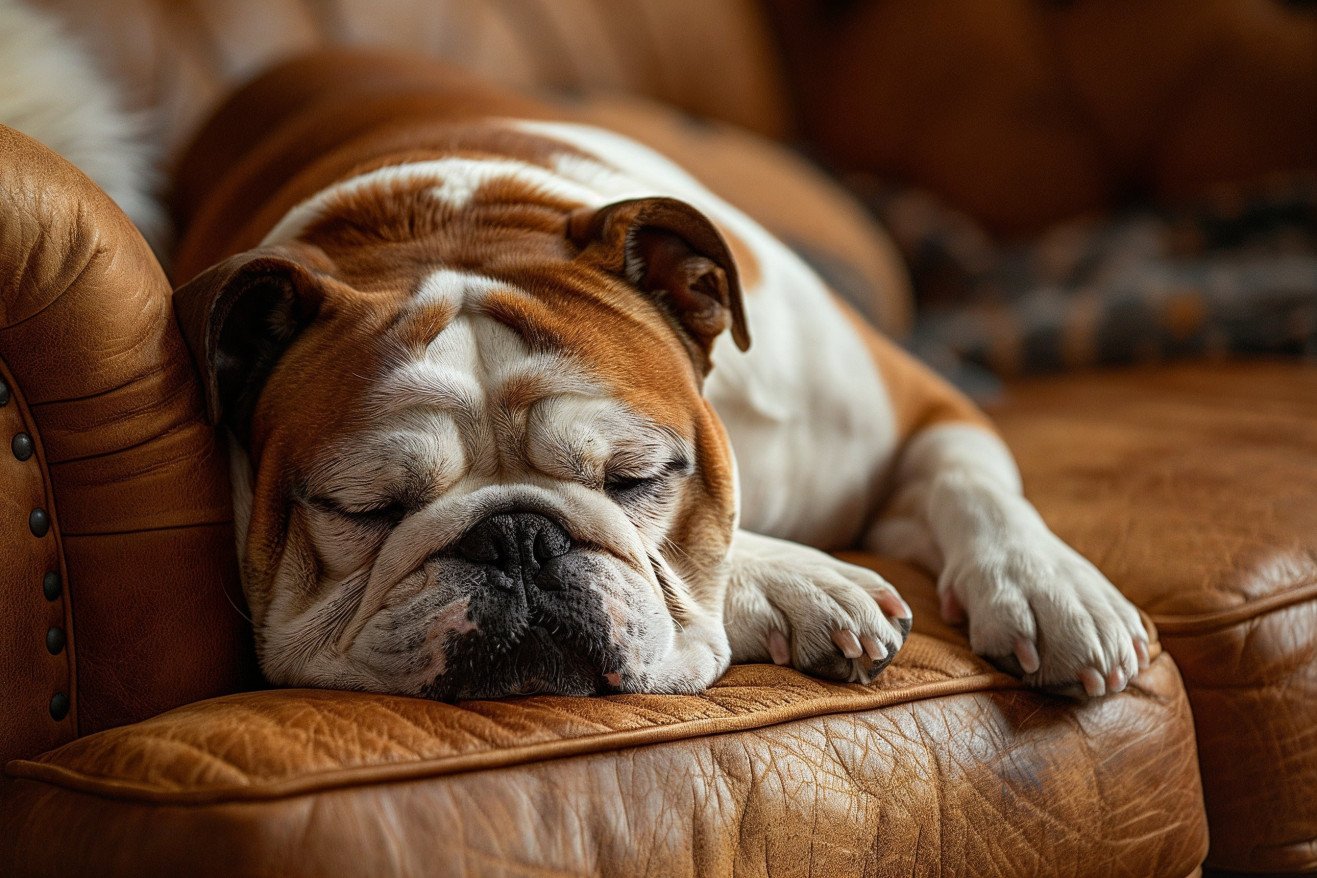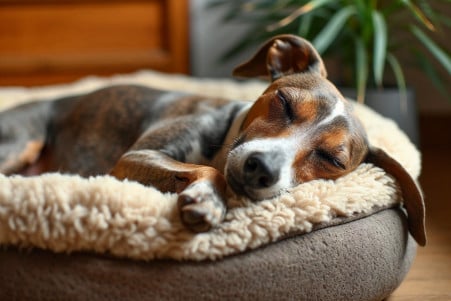Why Do Dogs Twitch in Their Sleep? Uncovering Canine Dreams
8 May 2024 • Updated 7 May 2024

If you’ve ever noticed your dog’s legs moving or heard them making little noises while they’re asleep, you may have wondered if dogs dream and, if so, what they dream about. It turns out that dogs do dream, and the movements you see are likely related to the dream activity that happens in their brains during sleep, including the possibility that they are reenacting past experiences or behaviors like hunting.
Although we still don’t know everything there is to know about dog dreams, we do have some new research to help us understand the physiological processes that govern dog sleep and dreams. In this article, we’ll explore the role of brain wave patterns, sleep stages, and the influence of evolution to help you better understand your dog’s inner world and the ways that dreams are rooted in biology.
Why do dogs twitch in their sleep?
REM Sleep and Brain Waves in Canine Dreams
Dogs go through different sleep cycles, including rapid eye movement (REM) sleep, which is known to be the sleep phase in which dreams are most vivid. REM sleep is characterized by increased brain wave activity and is when dreams are most likely to occur. It is also the phase of sleep when the brain's ability to control the body's muscles is temporarily shut off, resulting in the twitches and other movements that dogs experience during sleep.
Studies have shown that dogs' brains are active in much the same way during REM sleep as when they are awake, indicating that they are likely dreaming about their daily experiences and the things they do. In fact, some research has shown that dogs of certain breeds may even exhibit breed-specific behaviors during REM sleep, suggesting that dogs are dreaming about their innate and learned behaviors.
The pons, a part of the brain stem, is responsible for shutting off the body's muscles during REM sleep. This means that the pons is responsible for the twitches and other movements that dogs experience during sleep. It also means that the pons is responsible for preventing dogs from acting out their dreams. Understanding the relationship between REM sleep, brain waves, and muscle activity can help researchers better understand the phenomenon of dog dreaming and how it compares to human dreaming. This also brings up the question of how sleep twitching may vary between puppies and adult dogs.
Age-Related Differences in Sleep Twitching
Puppies show more and more intense signs of twitching during sleep than adult dogs, according to a study of dog sleep patterns. This is likely because the part of the brain stem that controls muscle activity during sleep is either underdeveloped or not yet fully functional in puppies.
As a result, puppies show more signs of twitching during sleep than adult dogs. As puppies mature, the signs of twitching during sleep tend to decrease. Research has found that 16-week-old puppies sleep more during the day than adult dogs but less at night. Meanwhile, senior dogs may show more signs of twitching during sleep as a result of age-related changes or the deterioration of the parts of the brain that control muscle activity during sleep.
Knowing about these differences can help dog owners understand what's normal in terms of sleep for their pets at different life stages. This knowledge can be reassuring and also make it easier to spot worrisome changes that may require a visit to the vet.
How to Deal With Excessive or Problematic Sleep Twitching in Dogs
If your dog is twitching during sleep, there is no need to worry. However, if the twitching is excessive or prolonged, there may be a problem that needs to be addressed by a veterinarian. Forbes Advisor notes that if a dog is growling, barking, or moving in an aggressive way while they are asleep, it may be a sign that they are having a nightmare or night terror.
If your dog is having frequent nightmares or night terrors, this could be a sign of a sleep disorder or another issue that needs to be addressed by a vet. The Whole Dog Journal says that larger dogs are more likely to have more intense dreams and night terrors than smaller dogs.
To help your dog deal with excessive sleep twitching, make sure that they have a comfortable place to sleep, a regular sleep schedule, and plenty of exercise and mental stimulation during the day. However, if the twitching doesn't go away or gets worse, or if it is accompanied by other symptoms, you should take your dog to the vet to get a proper diagnosis and treatment.
Medical Issues That May Cause Abnormal Sleep Twitching
While sleep twitching is usually normal, in some cases, it may be a sign of an underlying medical issue. Tractive lists seizures, infections, blood sugar imbalances, arthritis, and cognitive decline as some of the medical problems that could cause abnormal twitching or shaking during sleep.
Symptoms that may indicate the twitching is due to a seizure include vomiting, drooling, disorientation, and stiff or uncontrolled body movements. Caring Hearts Animal Hospital also says that while seizures are more likely to happen when dogs are awake, they can still happen during sleep.
If the twitching is extreme, disrupts the dog’s sleep, or is accompanied by other symptoms, it’s important to see a veterinarian to get an accurate diagnosis and appropriate care. Dogster explains that if medical issues are causing the twitching, the symptoms will only get worse and more complicated if they’re not treated, so it’s important to get help if you notice any abnormal sleep twitching.
How to Tell If Your Dog's Twitching Is Normal or a Sign of a Medical Issue
It's important for pet parents to be able to tell the difference between normal, harmless sleep twitching and twitching that could be a sign of a medical issue. AOL reports that normal sleep twitching is usually short, relaxed, and may include leg twitches, vocalizations, or facial expressions that indicate dreaming.
On the other hand, twitching that's a result of a seizure or another medical issue is often longer, stiffer, and may include full-body convulsions or a loss of consciousness. Other signs that the twitching may be a sign of a medical issue include vomiting, confusion, labored breathing, or the inability to wake your dog from sleep.
If you notice any of these symptoms or if your dog's twitching is severe or preventing them from getting a good night's sleep, it's best to take them to the vet as soon as possible. Being able to tell the difference between normal and abnormal sleep twitching is important for making sure our furry friends stay happy and healthy.
Conclusion: Embracing the Wonder of Canine Dreams
While twitching during sleep is often normal, in some cases, it may be a symptom of an underlying health condition that requires medical attention. According to Tractive, seizures, infections, blood sugar imbalances, arthritis, and cognitive decline are among the potential health issues that can cause abnormal twitching or shaking during sleep.
Symptoms that may indicate the twitching is the result of a seizure include vomiting, drooling, disorientation, and stiff or uncontrollable movements. Caring Hearts Animal Hospital notes that while seizures are more common during waking hours, they can also occur during sleep.
If the twitching is excessive, disruptive to the dog's sleep, or accompanied by other symptoms, it is important to see a veterinarian for a proper diagnosis and treatment. According to Dogster, leaving health issues untreated can result in the worsening of symptoms and the development of more serious problems, so it's important to address any abnormal sleep twitching as soon as possible.
Embracing the wonder of canine dreams can deepen our bond with our beloved pets and foster a greater understanding of their unique experiences.


